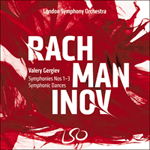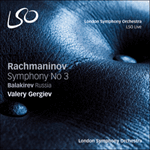
Welcome to Hyperion Records, a British classical label devoted to presenting high-quality recordings of music of all styles and from all periods from the twelfth century to the twenty-first.
Hyperion offers both CDs, and downloads in a number of formats. The site is also available in several languages.
Please use the dropdown buttons to set your preferred options, or use the checkbox to accept the defaults.

| London Symphony Orchestra, Valery Gergiev (conductor)» More |
A slow, evocative theme in the Dorian mode transposed (‘It was not the wind’) is used as an introduction and epilogue, and two fast dance themes are employed in the main, sonata-form Allegro moderato. ‘It was not the wind’ gives a feeling of epic antiquity and is felicitously repeated and developed in differing surroundings in a manner to be used by Tchaikovsky in the original version of the first movement of his second symphony, much influenced by this work. The two folk dance themes, one in the major and the other in the minor mode, are bridged by a version of ‘It was not the wind’, which also recurs in combination with them in the development section, so that it is totally integrated into the structure in a manner which gives intellectual as well as poetic satisfaction. A new, original melody serves to flesh out the material, occurring towards the end of the exposition and in the recapitulation.
The work finishes as it began, but with the addition of the first dance theme which is ingeniously incorporated in the slow closing bars creating, in the end, a magic caught only for a moment before its elusive aural fragrance fades. The creative imagination displayed by Balakirev is of a very high order, and he was right to be proud of this seminal and beautiful composition.
from notes by Edward Garden © 1998
Un lent thème évocatif dans le mode dorien transposé («Ce n’était pas le vent») est utilisé en introduction et en épilogue, et les deux thèmes rapides de danse sont utilisés dans l’Allegro-moderato principal, en forme de sonate. «Ce n’était pas le vent» donne une impression d’antiquité épique, et il est répété et développé avec félicité dans différents cadres d’une manière qui sera utilisée par Tchaïkovsky dans la version originale du premier mouvement de sa seconde symphonie, qui est très influencée par ce morceau. Les deux thèmes de danses folkloriques, une dans le mode majeur, l’autre dans le mineur, sont liées par une version de «Ce n’était pas le vent», qui ré-apparaît combiné avec elles dans la section du développement, de sorte qu’elle est totalement intégrée dans la structure d’une manière qui satisfait intellectuellement autant que poétiquement. Une nouvelle mélodie originale sert à donner du corps au matériau; elle survient vers la fin de l’exposition et dans la récapitulation.
L’ouvrage se termine comme il a commencé, mais avec l’adjonction du thème de la première danse qui est incorporé de façon ingénieuse dans les lentes dernières mesures. Cela crée, à la fin, une magie qui ne dure qu’un instant avant que sa fragrance élusive sonore ne disparaisse. L’imagination créative que montre Balakirev est de tout premier ordre et il avait raison d’être fier de cette belle et féconde composition.
extrait des notes rédigées par Edward Garden © 1998
Français: Alain Midoux
Ein langsames sinnträchtiges Thema im übertragenen dorischen Modus („Es war nicht der Wind“) wird als Introduktion und Epilog benutzt, während zwei schnelle Tanzthemen in das eigentliche Allegro moderato in Sonatensatzform eingehen. „Es war nicht der Wind“ vermittelt ein Gefühl epischer Ehrwürdigkeit und wird in unterschiedlichem Kontext gekonnt wiederholt und durchgeführt. Das gleiche Verfahren nutzte Tschaikowski für die Originalversion des ersten Satzes seiner 2. Sinfonie, die von diesem Werk stark beeinflußt wurde. Die beiden Volkstanzthemen, eines in Dur und eines in Moll, sind untereinander verknüpft über eine Variante von „Es war nicht der Wind“, das außerdem in Verbindung mit ihnen in der Durchführung wiederkehrt und somit auf intellektuell wie poetisch zufriedenstellende Weise ganz in die Struktur integriert ist. Eine neue Originalmelodie trägt dazu bei, dem Material Substanz zu verleihen, wenn sie gegen Ende der Exposition und in der Reprise in Erscheinung tritt.
Das Werk endet, wie es begann, allerdings unter Zusatz des ersten Tanzthemas, das geschickt in die langsamen Schlußtakte verwoben wird und im Ausklingen einen Zauber bewirkt, der nur einen Moment lang spürbar ist, ehe sich sein zartes akustisches Aroma verflüchtigt. Die kreative Fantasie, die Balakirew beweist, ist von sehr hohem Niveau, und er war mit Recht stolz auf diese zukunftsträchtige und schöne Komposition.
aus dem Begleittext von Edward Garden © 1998
Deutsch: Anne Steeb/Bernd Müller
 Rachmaninov: Symphonies Nos 1-3 & Symphonic Dances Rachmaninov: Symphonies Nos 1-3 & Symphonic DancesA new collection bringing together Valery Gergiev’s acclaimed cycle of the complete Rachmaninov symphonies with the London Symphony Orchestra. Also included are the Symphonic Dances and two symphonic poems by Mili Balakirev.» More |
 Rachmaninov: Symphony No 3; Balakirev: Russia Rachmaninov: Symphony No 3; Balakirev: RussiaMore swashbuckling Rachmaninov from the baton of Valery Gergiev, along with Balakirev's evocative overture 'Russia'.» More |

